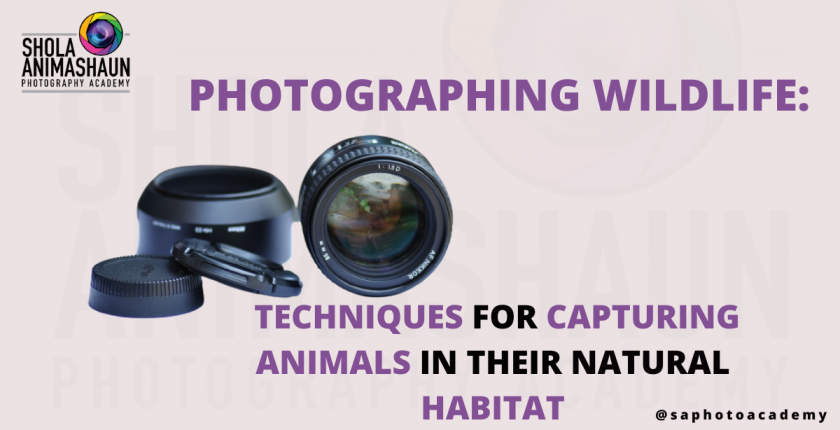Our Blog
Photographing Wildlife: Techniques for Capturing Animals in Their Natural Habitat
- June 16, 2023
- Posted by: Semilore Adelola
- Category: General Tips Photography Tips

Photographing wildlife in their natural habitat is a thrilling and rewarding experience for photographers. It allows us to capture the beauty, behavior, and essence of animals in their truest form.
However, it can also be a challenging endeavor that requires patience, skill, and careful planning. In this article, we will explore practical techniques and tips to help you improve your wildlife photography and capture stunning images of animals in their natural environment.
1. Research and Preparation:
Before heading out to photograph wildlife, it’s essential to conduct thorough research about the location, the animals you wish to photograph, and their behavior.
Understanding their habits, movement patterns, and habitats will significantly increase your chances of capturing compelling shots. Learn about the best times of day for wildlife sightings and the specific locations where your target species are commonly found.
2. Equipment Selection:
Choosing the right equipment is crucial for wildlife photography. A DSLR or mirrorless camera with a telephoto lens is recommended to capture animals from a safe distance without disturbing them. Opt for a telephoto lens with a focal length of at least 200mm, but longer lenses, such as 300mm or 400mm, will allow you to get even closer shots.
Additionally, invest in a sturdy tripod or monopod to minimize camera shake and enhance image stability.When it comes to wildlife photography, having the right camera and lens combination can significantly impact the quality and versatility of your images. Here is a list of cameras and lenses that are widely regarded as suitable for wildlife photography:
Cameras:
1. Canon EOS 5D Mark IV
2. Nikon D850
3. Sony Alpha A9 II
4. Fujifilm X-T4
5. Olympus OM-D E-M1X
6. Panasonic Lumix GH5
Telephoto Lenses:
1. Canon EF 100-400mm f/4.5-5.6L IS II USM
2. Nikon AF-S 200-500mm f/5.6E ED VR
3. Sony FE 200-600mm f/5.6-6.3 G OSS
4. Tamron SP 150-600mm f/5-6.3 Di VC USD G2
5. Sigma 150-600mm f/5-6.3 DG OS HSM Sports
Super-Telephoto Prime Lenses:
1. Canon EF 500mm f/4L IS II USM
2. Nikon AF-S 600mm f/4E FL ED VR
3. Sony FE 400mm f/2.8 GM OSS
4. Sigma 500mm f/4 DG OS HSM Sports
5. Olympus M.Zuiko Digital ED 300mm f/4 IS PRO
It’s important to note that the specific camera and lens combination you choose may depend on various factors, such as your budget, brand preference, and specific wildlife photography requirements. Also, there are many other camera models and lens options available on the market that may also be suitable for wildlife photography.
It’s recommended to try out different equipment and consult with professionals or fellow photographers to find the best fit for your needs and shooting style.
3. Patience and Observation:
Wildlife photography requires patience and keen observation skills. Spend time observing the animals and their behavior before attempting to photograph them. Look for signs of movement, feeding patterns, or interactions with other animals. This observation will help you anticipate their actions and capture more dynamic shots.
4. Composition and Framing:
When composing your wildlife shots, consider the rule of thirds and the natural environment of the animal. Positioning the animal off-center can create a more visually appealing composition.
Also, be aware of the background and foreground elements, ensuring they enhance the overall image. Look for leading lines, natural frames, or interesting textures that can add depth and context to your photographs.
5. Understanding Light:
Lighting plays a crucial role in wildlife photography. Whenever possible, photograph animals during the golden hours of sunrise and sunset, when the light is soft and warm. This creates a pleasing atmosphere and enhances the colors and textures of the animal and its surroundings.
Avoid harsh midday light, as it can create harsh shadows and wash out the details. If shooting in bright light, consider using a lens hood to minimize lens flare and using fill flash to balance the exposure.
6. Shutter Speed and Freezing Motion:
Wildlife photography often requires fast shutter speeds to freeze the motion of animals. Set your camera to shutter priority mode or manual mode, and select a high shutter speed to capture sharp images.
A minimum shutter speed of 1/500th of a second is generally recommended for smaller animals, while larger, faster-moving animals may require even faster speeds.
7. Use Continuous Shooting Mode:
Animals can move quickly, making it challenging to capture the perfect moment. Utilize your camera’s continuous shooting mode (burst mode) to capture a sequence of images in quick succession.
This increases your chances of capturing that decisive moment, such as a bird taking flight or an animal in mid-leap.
8. Respect Wildlife and Their Habitat:
While photographing wildlife, it’s crucial to prioritize the well-being of the animals and respect their natural habitat. Maintain a safe distance to avoid causing stress or disturbance or perhaps, harm to yourself.
Use a long lens with high mm to get close-up shots without encroaching on their space. Avoid altering their behavior or habitat for the sake of a photograph.
Lastly, photographing wildlife in their natural habitat requires a combination of technical skills, patience, and a deep appreciation for nature. By conducting thorough research, selecting the right equipment, practicing observation, and implementing compositional techniques, you can capture stunning images of animals in their true element.
Remember, respect for wildlife and their environment should always be a priority. So, grab your camera, head into the wild, and let the beauty of nature unfold through your lens.
Leave a Reply Cancel reply
This site uses Akismet to reduce spam. Learn how your comment data is processed.
